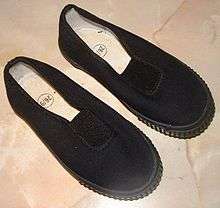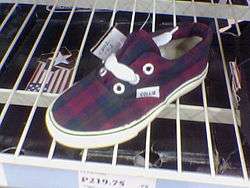Plimsoll shoe
| Look up plimsoll in Wiktionary, the free dictionary. |


A plimsoll shoe, plimsoll, plimsole or pumps (British English; see other names below) is a type of athletic shoe with a canvas upper and rubber sole developed as beachwear in the 1830s by the Liverpool Rubber Company.
Plimsolls had solid rubber soles about 8 or 9 mm thick, to which the canvas was glued without coming up the sides (as on trainers). The effect when running was similar to running without shoes.
The shoe was originally, and often still is in parts of the United Kingdom, called a "sand shoe" and acquired the nickname "plimsoll" in the 1870s. This name arose, according to Nicholette Jones's book The Plimsoll Sensation, because the coloured horizontal band joining the upper to the sole resembled the Plimsoll line on a ship's hull, or because, just like the Plimsoll line on a ship, if water got above the line of the rubber sole, the wearer would get wet.[1]
In the UK plimsolls are commonly worn for schools' indoor physical education lessons. Regional terms are common: in Northern Ireland and central Scotland they are sometimes known as gutties; "sannies" (from 'sand shoe') is also used in Scotland.[2] In parts of the West Country and Wales they are known as "daps" or "dappers". In London, the home counties, much of the West Midlands, the West Riding of Yorkshire and north west of England they are known as "pumps".[3] There is a widespread belief that "daps" is taken from a factory sign – "Dunlop Athletic Plimsoles" which was called "the DAP factory". However, this seems unlikely as the first citation in the Oxford English Dictionary of "dap" for a rubber soled shoe is a March 1924 use in the Western Daily Press newspaper; Dunlop did not acquire the Liverpool Rubber Company (as part of the merger with the Macintosh group of companies) until 1925. Plimsolls were issued to the British military (called 'road slappers' by the common soldiery) until replaced by trainers in the mid-80's. If white they required hours of application of shoe whitener, if black they were required to be polished until they gleamed.
As it was commonly used for corporal punishment in the British Commonwealth, where it was the typical gym shoe (part of the school uniform), plimsolling is also a synonym for a slippering.
Outside the United Kingdom
Plimsolls are referred to as:
- Australia – sandshoe or more simply with teenagers "canvas shoe", and include the similar shoe, the Dunlop Volley[4]
- Canada – also called running shoes, or runners
- France – "chaussures de tennis", or more simply "tennis"
- Gibraltar – Kung-Fu Shoes
- India – white plimsolls are often worn by school children and are known as Keds dating from the 1970s and earlier, and more commonly, as "canvas shoes". The brown version is used by most police and military units as a gym training shoe.
- Ireland – also called Penneys shoes/recession shoes if bought in Penneys (Primark). Occasionally called rubber dollies, especially in County Cork.
- Italy – "Scarpe da tennis" or "scarpe da ginnastica"; Superga or Converse like the name of the famous brands, these names commonly apply only to the same brands.
- Russia and Russian-speaking countries – Keds (Russian: ке́ды, kédy) after the famous American brand.
- South Africa – South African slang for shoes with a canvas upper and rubber sole is takkies.
- Spain – a "modern" substitute for traditional espadrilles, rubber soled canvas shoes were the standard shoe for decades, up to the 1970s. Trade mark Wamba became a household name, producing a universal unlaced indigo blue canvas shoe, worn by adults and children alike. Still today any kind of trainer shoe is known as Wambas in some parts of the country.
- United States – sneakers, tennis shoes, basketball shoes, Keds, or Chucks
- Portugal – Sapatos de lona or Sapatilhas
References
- ↑ "99% Invisible, Episode 33 – A Cheer for Samuel Plimsoll".
- ↑ "sannies – Dictionary of Playground Slang (Online)". www.odps.org. Retrieved 2010-01-19.
- ↑ "BBC Word Map – enter What they wear and Child's soft shoes". www.bbc.co.uk. Retrieved 2011-09-27.
- ↑ "Sneaker pimps". The Sydney Morning Herald. 2005-06-21.